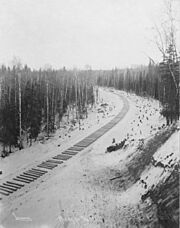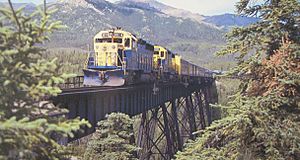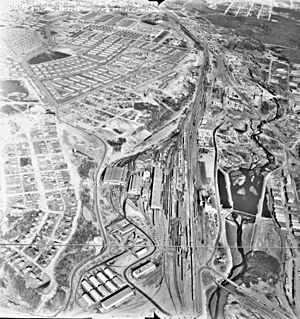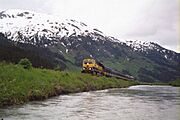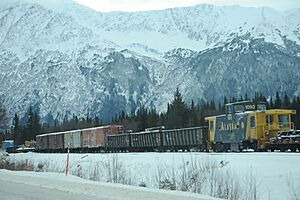Alaska Railroad facts for kids
Quick facts for kids Alaska Railroad |
|
|---|---|
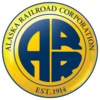 |
|
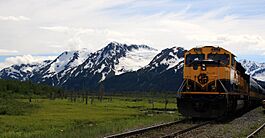
An Alaska Railroad passenger excursion train at Spencer Glacier.
|
|
| Overview | |
| Owner | State of Alaska |
| Locale | Alaska |
| Service | |
| Type | Freight and passenger railroad |
| Services | 5 |
| Daily ridership | 200 (weekdays, Q1 2023) |
| Ridership | 220,400 (2022) |
| History | |
| Commenced | 1903 |
| Purchase by US Government | March 12, 1914 |
| Completed | July 15, 1923 |
| Transfer to state | January 6, 1985 |
| Technical | |
| Line length | 470 miles (760 km) (mainline) |
| Track length | 656 miles (1,056 km) |
| Track gauge | 4 ft 8 1⁄2 in (1,435 mm) standard gauge |
| Old gauge | 3 ft (914 mm) (former Tanana Valley Railroad) |
| Signalling | Centralized traffic control or track warrant control with positive train control |
The Alaska Railroad (reporting mark ARR) is a Class II railroad that operates freight and passenger trains in the state of Alaska. The railroad's mainline runs between Seward on the southern coast and Fairbanks, near the center of the state. It passes through Anchorage and Denali National Park, to which 17% of visitors travel by train.
The railroad has 656 miles (1,056 km) of track, including sidings, rail yards and branch lines. The main line between Seward and Fairbanks is over 470 miles (760 km) long. The branch to Whittier conveys freight railcars interchanged with the contiguous United States via rail barges sailing between the Port of Whittier and Harbor Island in Seattle.
Construction of the railroad started in 1903 when the Alaska Central Railroad built a line starting in Seward and extending 50 miles (80 km) north. The Alaska Central went bankrupt in 1907 and was reorganized as the Alaska Northern Railroad Company in 1911, which extended the line another 21 miles (34 km) northward. On March 12, 1914, the U.S. Congress agreed to fund construction and operation of an all-weather railroad from Seward to Fairbanks and purchased the rail line from the financially struggling Alaska Northern.
As the government started building the estimated $35 million railroad, it opened a construction town along Ship Creek, eventually giving rise to Anchorage, now the state's largest city. In 1917, the government purchased the narrow gauge Tanana Valley Railroad, mostly for its railyard in Fairbanks. The railroad was completed on July 15, 1923 with President Warren G. Harding traveling to Alaska to drive a ceremonial golden spike at Nenana. Ownership of the railroad passed from the federal government to the state of Alaska on January 6, 1985.
In 2022, the system had a ridership of 220,400, or about 200 per weekday as of the first quarter of 2023. In 2019, the company generated a US$21.6 million profit on revenues of US$203.9 million, holding US$1.1 billion in total assets.
Contents
History
In 1903 a company called the Alaska Central Railroad began to build a rail line beginning at Seward, near the southern tip of the Kenai Peninsula in Alaska, northward. The company built 51 miles (82 km) of track by 1909 and went into receivership. This route carried passengers, freight and mail to the upper Turnagain Arm. From there, goods were taken by boat at high tide, and by dog team or pack train to Eklutna and the Matanuska-Susitna Valley.
In 1909, another company, the Alaska Northern Railroad Company, bought the rail line and extended it another 21 miles (34 km) northward. From the new end, goods were floated down the Turnagain Arm in small boats. The Alaska Northern Railroad went into receivership in 1914.
At about this time, the United States government was planning a railroad route from Seward to the interior town of Fairbanks. President William Howard Taft authorized a commission to survey a route in 1912. The line would be 656 miles (1,056 km) long and provide an all-weather route to the interior.
In 1914, the government bought the Alaska Northern Railroad and moved its headquarters to Ship Creek, in what would later become Anchorage. The government began to extend the rail line northward.
In 1917, the Tanana Valley Railroad in Fairbanks was heading into bankruptcy. It owned a small 45-mile (72 km) 3 ft (914 mm) (narrow gauge) line that serviced the towns of Fairbanks and the mining communities in the area as well as the boat docks on the Tanana River near Fairbanks.
The government bought the Tanana Valley Railroad, principally for its terminal facilities. The section between Fairbanks and Happy was converted to dual gauge to complete the 4 ft 8 1⁄2 in (1,435 mm) standard gauge line from Seward to Fairbanks. The government extended the southern portion of the track to Nenana, and later converted the extension to standard gauge. The Alaska Railroad continued to operate the remaining TVRR narrow gauge line as the Chatanika Branch (the terminus was located near the Yukon River), until decommissioning it in 1930.
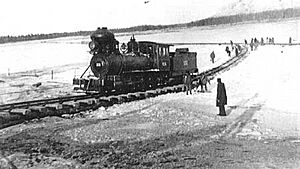
In 1923 they built the 700-foot (213 m) Mears Memorial Bridge across the Tanana River at Nenana. This was the final link in the Alaska Railroad and at the time, was the second longest single-span steel railroad bridge in the country. U.S. President Warren G. Harding drove the golden spike that completed the railroad on July 15, 1923, on the north side of the bridge. The railroad was part of the US Department of the Interior.
The Alaska Railroad's first diesel locomotive entered service in 1944. The railroad retired its last steam locomotive in 1966.
In 1958, land for the future Clear Air Force Station was purchased. (Clear is about 15 kilometers (9.3 mi) south of Nenana.) Approximately 40,000 feet (12 km) of track were diverted, and later a spur was constructed to deliver coal to its power station.
The railroad was greatly affected by the Good Friday earthquake, which struck southern Alaska in 1964. The yard and trackage around Seward buckled and the trackage along Turnagain Arm was damaged by floodwaters and landslides. It took several months to restore full service along the line.
In 1967, the railroad was transferred to the Federal Railroad Administration, an agency within the newly created United States Department of Transportation.
In 1975-76, an infusion of $15 million from the DOT enabled various capital improvements including those to facilitate hauling materials for the Alaska Pipeline.
On January 6, 1985, the state of Alaska bought the railroad from the U.S. government for $22.3 million, based on a valuation determined by the US Railway Association. The state immediately invested over $70 million on improvements and repairs that compensated for years of deferred maintenance. The purchase agreement prohibits the Alaska Railroad from paying dividends or otherwise returning capital to the state of Alaska, unlike the state's other quasi-corporations: the Alaska Permanent Fund, the Alaska Housing Finance Corporation, and the Alaska Industrial Development and Export Authority.
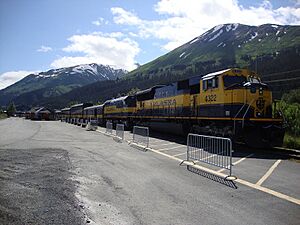
Proposed expansion in Alaska
Northern Rail Extension to Delta Junction
An extension of the railroad from Fairbanks to Delta Junction over a bridge spanning the Tanana River was envisioned as early as 2009. The 2011 Alaska state budget would provide $40 million in funding for the bridge, which initially be only for vehicular use. The United States Department of Defense would provide another $100 million in funds, as the bridge and a subsequent rail line would provide year-round access to Fort Greely and the Joint Tanana Training Complex. Groundbreaking ceremony for the Tanana River Bridge took place on September 28, 2011, and the new bridge was opened (for military road traffic only) in 2014.
Point MacKenzie Line
On 21 November 2011, the Surface Transportation Board approved the construction of a new 25-mile (40 km) line between Port MacKenzie and the existing main line at Houston, Alaska. As of May 2023 this spur line had not been completed.
Anchorage Vicinity Service
A spur line was built to Ted Stevens International Airport in 2003, along with a depot, officially named after Bill Sheffield. The line never received scheduled service but cruise lines charter trains to convey passengers between ships and the airport. The railroad currently leases the depot to citizens for private events such as conferences, seminars, and corporate functions.
There are plans to provide commuter rail service within the Anchorage metropolitan area (Anchorage to Mat-Su Valley via Eagle River, north Anchorage to south Anchorage); additional tracks would be necessary to accommodate the heavy freight traffic.
Proposed connection to the contiguous 48 states
In 2001 federal legislation, sponsored by Republican U.S. senator (and later Alaska governor) Frank Murkowski, formed a bilateral commission to study feasibility of building a rail link between Canada and Alaska; Canada was asked to be part of the commission, but the Canadian federal government did not choose to join the commission or commit funds for the study. However, the Yukon territorial government did show some interest.
A June 2006 report by the commission recommended Carmacks, Yukon, as a hub, with three possibilities: A line could go northward to Delta Junction, Alaska (Alaska Railroad's northern end-of-track). Another line could go from Carmacks to Hazelton, British Columbia (which is served by the CN), passing through Watson Lake, Yukon, and Dease Lake, British Columbia. The third line could go from Carmacks to either Haines or Skagway, Alaska. The latter path by way of Whitehorse, Yukon, the northern terminus of the 3 ft (914 mm) (narrow-gauge) White Pass and Yukon Route Railroad). However, currently the latter's trains only reach Carcross, Yukon, because service has not been completely restored following a 1982 embargo of the entire line.
Following the demise of the ill-fated Keystone XL Pipeline project, the Alaska Canada Rail Link (ACRL) was rekindled as an alternative. In November 2015, the National Post reported that a link between the southern provinces and the Alaska Railroad was again being considered by the Canadian federal government, this time routing to Alberta. In this scenario, the route would originate at Delta Junction and use Carmacks as a hub, as in prior plans. The route would continue through Watson Lake, Yukon, en route to a stop at Fort Nelson, British Columbia. It would continue to Peace River, Alberta, with its southern terminus at Fort McMurray. The route was endorsed by the Assembly of First Nations. It was unclear whether this rail connection would ever be utilized for passenger service.
On September 25, 2020, then President Donald Trump announced he would issue a presidential permit to the Alaska-Alberta Railway Development Corporation (A2A Railway), which had an agreement with Alaska Railway to develop a joint operating plan for the rail connection to Canada. The proposed A2A Railway would have connected to the Alaska Railroad at North Pole, Alaska, and run through Yukon Territory to Fort Nelson, and from there to a terminus at Fort McMurray, Alberta. (The A2A Railway had also been negotiating with the Mat-Su Borough on an agreement to complete the Port Mackenzie Railway Extension.)
Executives
General managers under federal ownership
- Col. Frederick Mears, 1919-1923 (was originally head of the railroad as chairman of the Alaska Engineering Commission)
- Col. James Gordon Steese, 1923-1923
- Lee H. Landis, 1923–1924
- Noel W. Smith, 1924–1928
- Col. Otto F. Ohlson, 1928–1945
- Col. John P. Johnson, 1946–1953
- Frank E. Kalbaugh, 1953–1955
- Reginald N. Whitman, 1955–1956
- John H. Lloyd, 1956–1958
- Robert H. Anderson, 1958–1960
- Donald J. Smith, 1960–1962
- John E. Manley, 1962–1971
- Walker S. Johnston, 1971-1975
- William L. Dorcy, 1975–1979
- Steven R. Ditmeyer (Acting) 1979-1980
- Frank H. Jones, 1980–1985
Railroad Corporation Police
The Alaska Railroad Corporation has its own police force
Presidents under state ownership
- Frank Turpin, 1985-1991
- Robert Hatfield Jr., 1991–1997
- Bill Sheffield, 1997–2001
- Patrick K. Gamble, 2001–2010
- Christopher Aadnesen, 2010–2013
- Bill O'Leary, 2013–present
Routes and tourism
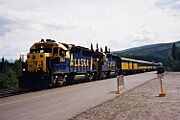
The railroad is a major tourist attraction in the summer. Coach cars feature wide windows and domes. Private cars owned by the major cruise companies are towed behind the Alaska Railroad's own cars, and trips are included with various cruise packages.
Routes
- The Denali Star runs from Anchorage to Fairbanks (approximately 12 hours one-way) and back with stops in Talkeetna and Denali National Park, from which various flight and bus tours are available. The Denali Star only operates between May 15 and September 15. Although the trip is only about 356 miles (573 km), it takes 12 hours to travel from Anchorage to Fairbanks as the tracks wind through mountains and valleys; the train's top speed is 59 miles per hour (95 km/h) but sometimes hovers closer to 30 miles per hour (48 km/h).
- The Aurora Winter Train is available in winter months (September 15 - May 15) on a reduced weekend-only schedule (Northbound, Saturday mornings; Southbound, Sunday mornings) between Anchorage and Fairbanks on the same route as the Denali Star.
- The Coastal Classic winds its way south from Anchorage along Turnagain Arm before turning south to the Kenai Peninsula, eventually reaching Seward. This 114-mile (183 km) trip takes around four and a half hours due to some slow trackage as the line winds its way over mountains.
- The Glacier Discovery provides a short (2-hour) trip south from Anchorage to Whittier for a brief stop before reversing direction for a stop at Grandview while returning to Anchorage in the evening.
- The Hurricane Turn provides rail service to people living between Talkeetna and the Hurricane area. This area has no roads, and the railroad provides the lifeline for residents who depend on the service to obtain food and supplies. One of the last flag-stop railway routes in the United States, passengers can board the Hurricane Turn anywhere along the route by waving a large white flag or cloth.
- A spur providing service to the Ted Stevens Anchorage International Airport is used during the summer season for cruise ship service only. It was activated temporarily during the Alaska Federation of Natives (AFN) 2006 convention to provide airport-to-hotel mass transit for delegates.
Rolling stock
By 1936, the company had rostered 27 steam locomotives, 16 railcars, 40 passenger cars and 858 freight cars.
Active
As of 2022[update], Alaska Railroad rosters a total of 51 locomotives, two control cab units, and one DMU (self-propelled railcar):
- 28 EMD SD70MAC locomotives (12 equipped with head-end power for passenger service)
- 15 EMD GP40-2 locomotives
- 8 EMD GP38-2 locomotives
- 2 EMD F40PH control cab units
- 1 Colorado Railcar DMU
Retired
- Budd Rail Diesel Car (RDC) (Retired 2009; sold to TriMet, in Oregon, as spare equipment for its WES Commuter Rail service)
- EMD MP15AC (Retired 2009)
- EMD F7
- EMD FP7 (Two units, 1510 and 1512 sold to Verde Canyon Railroad in Arizona for excursions)
Other
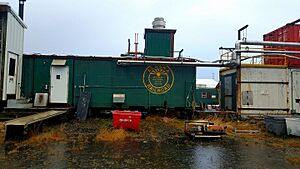
In 2011 the Alaska Railroad reacquired ARR 557, the last steam locomotive bought new by the railroad and the last steam locomotive used by the railroad, with the intent to refurbish and operate it in special excursions between Anchorage and Portage.
A USATC S160 "2-8-0 Consolidation" engine built in 1944 by Baldwin Locomotive Works, 557 was originally coal-fired but was converted to oil in 1955. It operated until 1964, when it was deemed surplus and sold as scrap. It was purchased by Monte Holm of Moses Lake, Washington and displayed in his House of Poverty Museum.
After Holm's death in 2006, Jim and Vic Jansen bought 557 from the museum and returned it to the Alaska Railroad on the condition that it be restored to operation and put into service.
The locomotive was sold to the non-profit Engine 557 Restoration Company for "One Dollar ($1.00) and other good and valuable considerations" and they have invested (as of January 2019[update]) 77 months and over 75,000 hours of volunteer time in the restoration and overhaul.
See also
 In Spanish: Ferrocarril de Alaska para niños
In Spanish: Ferrocarril de Alaska para niños
- Alaskan Engineering Commission, the Federal agency which constructed the Alaska railways
- Anton Anderson Memorial Tunnel
- Transportation in North America
- White Pass and Yukon Route


